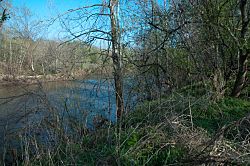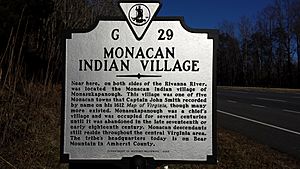Shadwell, Virginia facts for kids
Quick facts for kids
Shadwell, Virginia
|
|
|---|---|

A view of the Rivanna at Shadwell
|
|
| Nickname(s):
"Birthplace of Thomas Jefferson"
|
|
| Country | United States |
| State | Virginia |
| County | Albemarle |
| Elevation | 361 ft (110 m) |
| Time zone | UTC-5 (Eastern (EST)) |
| • Summer (DST) | UTC-4 (EDT) |
| ZIP Code |
22947
|
| Area code(s) | 434 |
Shadwell is a small community in Albemarle County, Virginia. It is located near the Rivanna River and the city of Charlottesville. Shadwell is famous as the birthplace of Thomas Jefferson, who later became the third President of the United States. Today, a special marker shows where his home once stood. Two historic homes, Clifton and Edge Hill, are also located in the Shadwell area.
Before European settlers arrived, Monacan Native American people used trails that went through what is now Shadwell. In the mid-1700s, Peter Jefferson, Thomas Jefferson's father, started a large farm called Shadwell. For four generations, the Jefferson family lived there. At first, it was a farm where tobacco, grain, and clover were grown, with the help of both free and enslaved people. Later, a grist mill (for grinding grain), a sawmill (for cutting wood), and a factory that prepared cotton were added. Canals and locks were built on the Rivanna River to help transport goods like lumber, flour, and cotton.
However, the factory burned down in the 1850s. Also, a new railroad, the Louisa Railroad, was built, which made river transport less important. Because of these changes, Shadwell's economy started to decline. The Shadwell estate then became a regular farm, run by Downing Smith. In 1991, archaeologists studied the area and found the remains of old building foundations. One of these is thought to be the original Jefferson family home.
Contents
History of Shadwell

Shadwell has a long and interesting history, from its early days as a Native American pathway to its time as a busy manufacturing town.
Early Beginnings
Long ago, Monacan Native American people had important trails that crossed through the area we now call Shadwell. Before Peter Jefferson bought the land, a few other early colonial settlers owned parts of Shadwell. The area began as a small settlement at a crossroads, where two important roads, Three Notch'd and Old Mountain Roads, met.
The Jefferson Family's Story

Peter Jefferson, a colonist and farmer, named the area "Shadwell" after a parish in London, England. This was where his wife, Jane Randolph Jefferson, had been christened. In 1736, Peter Jefferson bought 1,200 acres of land. He bought even more land later, bringing his main farm to 1,400 acres. He married Jane in 1739 and finished building their one-and-a-half-story house around 1741. This house was where Thomas Jefferson was born. Around 1757, Peter Jefferson also built a gristmill on the Rivanna River. Important Native American leaders, like Ontasseté, often visited Peter Jefferson at Shadwell when they were traveling to Colonial Williamsburg.
When his father died in 1764, Thomas Jefferson inherited the property. However, his mother had the right to live there for her lifetime, so Thomas leased the property from her until she passed away in 1776. From 1765 to 1794, Thomas Jefferson ran Shadwell as a tobacco farm. He had an overseer manage the work, which was done by both free people and enslaved people. In 1774, he had 18 enslaved people, but 12 of them were too young or too old to work. The farm included homes for enslaved people, barns for tobacco, stables, mills, and gardens.
In 1770, a fire destroyed the Jefferson family's house at Shadwell. Thomas Jefferson lost almost all of his books and important papers in the fire. After the fire, his mother had a smaller house built. Thomas moved to Monticello, his new home, after the fire. Even though he no longer lived at Shadwell, he continued to run it as a farm, growing different crops like clover, corn, and wheat. In 1771, a very big flood, one of the largest at that time, destroyed the gristmill. Thomas Jefferson later leased the farm and a large manufacturing mill he had built to others. In 1813, he gave the property to his grandson, Thomas Jefferson Randolph. The main house that stands today, about two miles from the original site, was built around 1849 by Thomas Jefferson's granddaughter, Caryanne Randolph Ruffin, and her husband, Colonel Frank Ruffin. They also called it Shadwell and raised their family there.
Shadwell as a Manufacturing Center
Shadwell grew into a busy manufacturing town. Goods like timber, tobacco, cotton products, and flour were transported on the Rivanna River. Peter Jefferson had built a dam, a mill, and a half-mile long mill race on the river around 1757. From 1789 until the 1860s, canals and locks were used at Shadwell to help move goods along the Rivanna River. Thomas Jefferson continued to operate a grist mill, a sawmill, and a factory that prepared cotton until he died in 1826.
By 1835, Shadwell was a thriving place. It had a large factory that prepared cotton, employing 100 workers. There was also a big merchant mill and a sawmill. The town had several general stores, shops, and private homes. Shadwell was doing very well until 1850, when the cotton factory burned down and was never rebuilt. The town also started to decline after the Louisa Railroad was built in the 1840s, running parallel to Three Notch'd Road. The railroad made river transport less important, which hurt Shadwell's economy.
Later Years and Discoveries
After the decline of manufacturing, Shadwell returned to being mainly a farming area. In 1879, Downing Smith bought 230 acres of Shadwell land. The next year, he built a house near where the original Jefferson home was thought to be. He eventually owned a total of 1,035 acres, including land from Shadwell and the nearby Edge Hill farm. After World War I, Shadwell saw more visitors as people began traveling by car for vacations. The train station at Shadwell closed in 1932.
In 1991, an archaeological study began at the site of the Jefferson's original Shadwell farm. During this study, two old cellar foundations were discovered. One of these is believed to be the foundation of the very first house where Thomas Jefferson was born.
Images for kids





